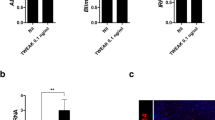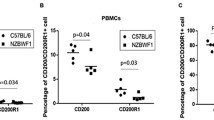Abstract
Objective
To observe the effects of Xuebijing Injection (血必净注射液) on dendritic cells (DCs) and T lymphocytes, and the potential mechanisms of its therapeutic effect on systemic lupus erythematosus (SLE).
Methods
A widely used mouse model, SLE-prone BLLF1 mice aged 8–10 weeks, was employed. Mice were randomly divided into 4 groups: a normal group, a model group and two treatment groups treated with Xuebijing Injection with a dose of 6.4 mL/kg via intraperitoneal administration for SLE-prone BLLF1 mice aged 8 weeks (treatment A group) and 10 weeks (treatment B group). Renal tissue sections were stained with Masson’s trichrome and periodic acid-silver methenamine. Histopathological changes in the kidney were evaluated by a light microscopy. The capacity of the DCs isolated from the spleen to stimulate the T cell proliferation in response to concanavalin A (Con A) was determined.
Results
Compared with the model group, levels of anti-dsDNA antibodies in the two treatment groups decreased remarkablely (P<0.01, P<0.05), and levels of serum creatinine and blood urea nitrogen increased (P<0.01, P<0.05). Pathological changes were found in the kidney in the model group. Histopathological abnormalities were alleviated in the two treatment groups. Treatment with Xuebijing injection also significantly upregulated the expression of CD80, CD86 and major histocompatibility class II by DCs compared with the model group (P<0.05). When splenic T lymphocytes from BLLF1 mice were co-cultured with DCs at ratios of 1:100, 1:150 and 1:200 for 3 and 5 days, the proliferation of T lymphocytes was suppressed compared with the normal group (P<0.05), but this was restored by Xuebijing Injection under the same conditions. In the model group, levels of tumor necrosis factor (TNF)-α in supernatants were significantly elevated compared with the normal group (P<0.01), interleukin-2 levels decreased (P<0.05), while these changes were significantly alleviated in the Xuebijing treatment groups.
Conclusions
Xuebijing Injection alleviated renal injury in SLE-prone BLLF-1 mice. The mechanism might be through influencing T cell polarization mediated by DCs, and Xuebijing Injection might be a potential drug that suppresses immune dysfunction in patients with SLE.
Similar content being viewed by others
References
Zhang LT, Yao YM, Dong N, Dong YQ, Yu Y, Sheng ZY. Relationship between high-mobility group box 1 protein release and T-cell suppression in rats after thermal injury. Shock 2008;30:449–455.
Zhu XM, Yao YM, Liang HP, Liu F, Dong N, Yu Y, et al. Effect of high mobility group box-1 protein on apoptosis of peritoneal macrophages. Arch Biochem Biophys 2009;492:54–61.
Berkun Y, Verboverski I, Ben-Ami A, Paran D. Altered dentritic cells with tolerizing phenotype in patients with systemic-lupus erythematosus. Eur J Immunol 2008;38:2896–2904.
Lechler R, Ng WF, Steinman RM. Dendritic cells in transplantation: friend or foe? Immunity 2001;14:357–368.
Banchereau J, Briere F, Caux C. Immunobiology of dendritic cells. Annu Rev Immunol 2000;18:767–811.
Steinman RM. The dendritic cell system and its role in immunogenicity. Annu Rev Immunol 1991;9:271–296.
Hart DN. Dendritic cells: unique leukocyte populations which control the primary immune response. Blood 1997;90:3245–3287.
Mellman I, Steinman RM. Dendritic cells: specialized and regulated antigen processing machines. Cell 2001;106:255–258.
Steinman RM. Dendritic cells: understanding immunogenicity. Eur J Immunol 2007;37:S53–S60.
Steinman RM. Lasker basic medical research award. dendritic cells: versatile controllers of the immune system. Nat Med 2007;13:1155–1159.
Pichlmair A, Reis E, Sousa C. Innate recognition of viruses. Immunity 2007;27:370–383.
Steinman RM, Hawiger D, Nussenzweig MC. Tolerogenic dendritic cells. Annu Rev Immunol 2003;21:685–711.
Dumitriu IE, Baruah P, Bianchi ME, Manfredi AA, Rovere-Querini P. Requirement of HMGB1 and RAGE for the maturation of human plasmacytoid dendritic cells. Eur J Immunol 2005;35:2184–2190.
Messmer D, Yang H, Telusma G, Knoll F, Li J, Messmer B, et al. High mobility group box protein 1: an endogenous signal for dendritic cell maturation and Th1 polarization. J Immunol 2004;173:307–313.
Dumitriu IE, Baruah P, Valentinis B, Voll RE, Herrmann M, Nawroth PP, et al. Release of high mobility group box 1 by dendritic cells controls T cell activation via the receptor for advanced glycation end products. J Immunol 2005;174:7506–7515.
Yang D, Chen Q, Yang H, Tracey KJ, Bustin M, Oppenheim JJ. High mobility group box-1 protein induces the migration and activation of human dendritic cells and acts as an alarmin. J Leukoc Biol 2007;1:59–66.
Flohé SB, Agrawal H, Schmitz D, Gertz M, Flohé S, Schade FU. Dendritic cells during polymicrobial sepsis rapidly mature but fail to initiate a protective Th1-type immune response. J Leukoc Biol 2006;79:473–481.
Yao YM, Chai YK, Lin HY, eds. Sepsis theory and practice. Beijing: Science Press; 2005:1112–1152.
Wan JM, Sit WH, Lee CL, Fu KH, Chan DK. Protection of lethal toxicity of endotoxin by Salvia miltiorrhiza Bunge is via reduction in tumor necrosis factor alpha release and liver injury. Int Immunopharmacol 2006;6:750–758.
Wang H, Li W, Li J, Rendon-Mitchell B, Ochani M, Yang L, et al. The aqueous extract of a popular berbal nutrient supplement, Angelica sinensis, protects mice against lethal endotoxemia and sepsis. J Nutr 2006;136:360–365.
Lv GF, Zheng J, Zhou H, Zheng YM, Wang LX, Wei G, et al. The screening and isolation of an effective anti-endotoxin monomer from Radix Paeoniae Rubra using affinity biosensor technology. Int Immunopharmaool 2005;5:1007–1017.
Author information
Authors and Affiliations
Corresponding author
Additional information
Supported by Grants from the National Natural Science Foundation (No. 81130035, 81071545, and 30971192), and the National Basic Research Program of China (No. 2012CB518102)
Rights and permissions
About this article
Cite this article
Wang, Yb., Wang, Q., Yao, Ym. et al. Effect of Xuebijing injection (血必净注射液) on systemic lupus erythematosus in mice. Chin. J. Integr. Med. 19, 675–682 (2013). https://doi.org/10.1007/s11655-013-1561-0
Received:
Published:
Issue Date:
DOI: https://doi.org/10.1007/s11655-013-1561-0




